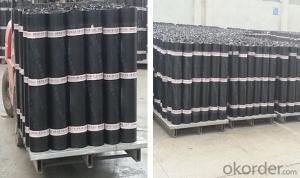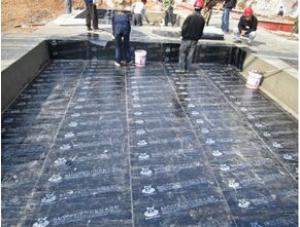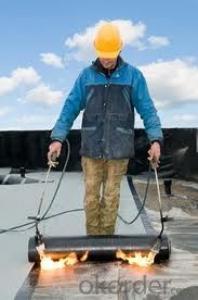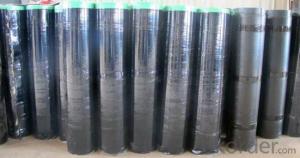SBS Elastomer Modified-bitumen Waterproof Membrane For Roof
- Loading Port:
- Shanghai
- Payment Terms:
- TT OR LC
- Min Order Qty:
- 1000 m²
- Supply Capability:
- 200000 m²/month
OKorder Service Pledge
OKorder Financial Service
You Might Also Like
product description:
SBS Waterproof Membrane using polyester reinforcement for waterproofing is a new type of wateproof material,it's made from polyester felt as its reinforcement featuring high strength,elongation amd corrision resistance, SBS compound as its modifier for meeting the torched-on applications, it shall be covered with polyethylene membrane(PE),aluminium foil, colorful sand or mineral granule on its top surface and polyethylene membrane(PE) coated on its under face. This series of membrane is designed for the waterproofing of underground construction such as tunnel, subway, basement,roofs and pools etc.
Characteristic
Good impermeability
Thinckness: 3mm,4mm,5mm
Length:8m,10m or customed
Being applied in the cold area with low temperature:0°C, -5°C, -10°C,-20°C, -25°C
Good performance in anti-puncture, anti-broker, anti-resistance, anti-erosion, anti-mildew, anti-weathering
Possess good tensile strength, elongation rate and size stability which could be well suited the substrate distortion and crack
Applicable scope:
It is widely used for civil building roofing, underground, bridge, parking, pool, tunnel in the line of waterproofing and dampproofing, especially for the building under high temperature.
Application
The needle-punched polyester is widely used as the carrier for waterproofing membrane production. The membrane made withneedle-punched polyester matis widely used for: Construction waterproofing; Moisture-proof in roof engineering, underground engineering, indoor ground, etc;Corrosion resistance for water pool or building bases.
Our Services
1.If you need some advises for the waterproof construction, we have the best engineer to serve you.
2.We send the free samples to you by freight collect.
3.We will guarantee the quality and the competitive price.
4.We will give you the best packaging and safe shipping.
5.If any problem, we will always be right here waiting for you.
Packaging & Shipping
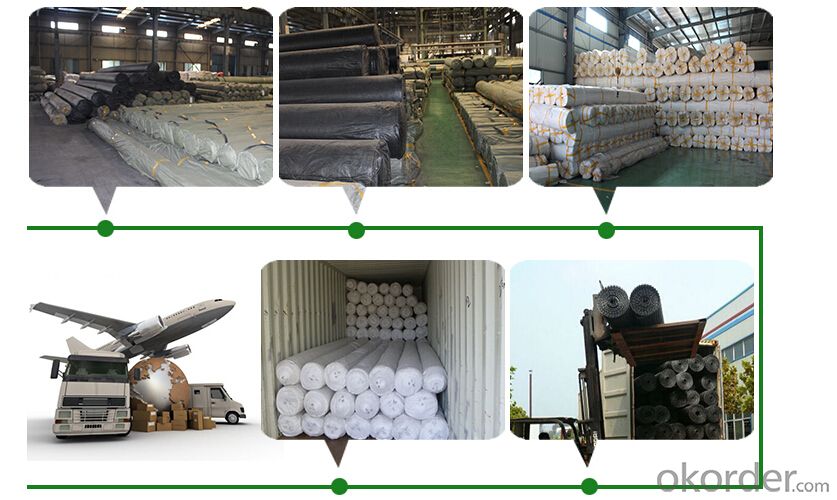
| Packing | Woven bag/PE bag packing or as customer request |
| Shipping | FOB Changsha,customized shipping terms and oppointed port accepted |
Technical parameter
| Item | Specifications | ||||||||
| Geotextile Unit Weight (g/m²) | 300 | 500 | 600 | 700 | 800 | 900 | 1000 | 1100 | |
| Geomembrane Thickness (mm) | 0.25-0.35 | 0.30-0.50 | |||||||
| Nominal Fracture Strength (KN/m) | 2.50 | 7.50 | 10 | 12 | 14 | 16 | 18 | 20 | |
| Breaking Strength (KN/m,≥,LD/TD) | 2.50 | 7.50 | 10 | 12 | 14 | 16 | 18 | 20 | |
| Standard Intensity Corresponding Elongation Rate (%) | 30~100 | ||||||||
| CBR Burst Strength (KN,≥) | 0.70 | 1.50 | 1.90 | 2.20 | 2.50 | 2.80 | 3.00 | 3.20 | |
| Longitudinal Tear Strength (KN,≥) | 0.05 | 0.25 | 0.32 | 0.40 | 0.48 | 0.56 | 0.62 | 0.70 | |
| Hydrostatic Pressve (Mpa) | See List Below | ||||||||
| Peel Strength (N/cm,≥) | 6 | ||||||||
| Vertical Permeability Coefficient (cm/s) | According to design or contract mentioned. | ||||||||
| Width Variation (%) | -1.00 | ||||||||
| Item | Geomembrane Thickness (mm) | ||||||||
| 0.20 | 0.30 | 0.40 | 0.50 | 0.60 | 0.70 | 0.80 | 1.00 | ||
| Hydrostatic Pressve (Mpa) | One geotextiles with one geomembrane | 0.40 | 0.50 | 0.60 | 0.80 | 1.00 | 1.20 | 1.40 | 1.60 |
| Two geotextiles with one geomembrane | 0.50 | 0.60 | 0.80 | 1.00 | 1.20 | 1.40 | 1.60 | 1.80 | |
Professional test machines ensure the products qualified roduct certifications
roduct certifications

Inquiry Note
How to send an effective inquiry for saving your time?
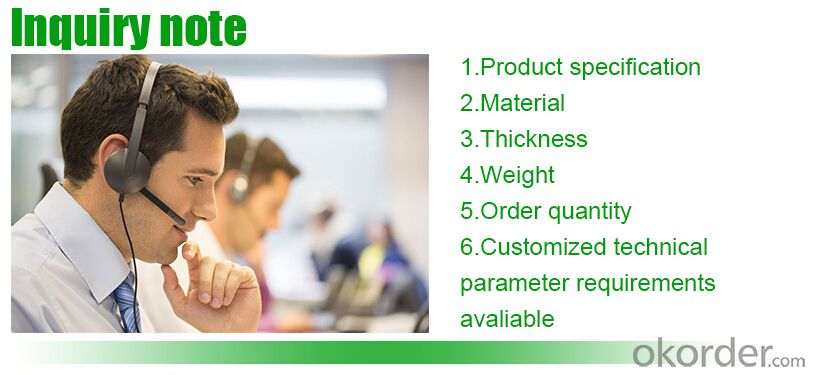
product show
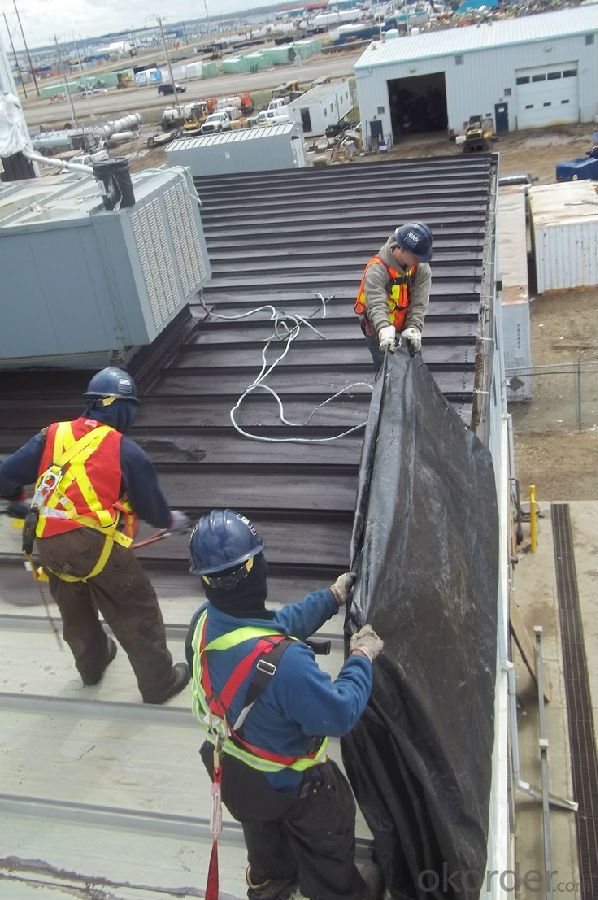
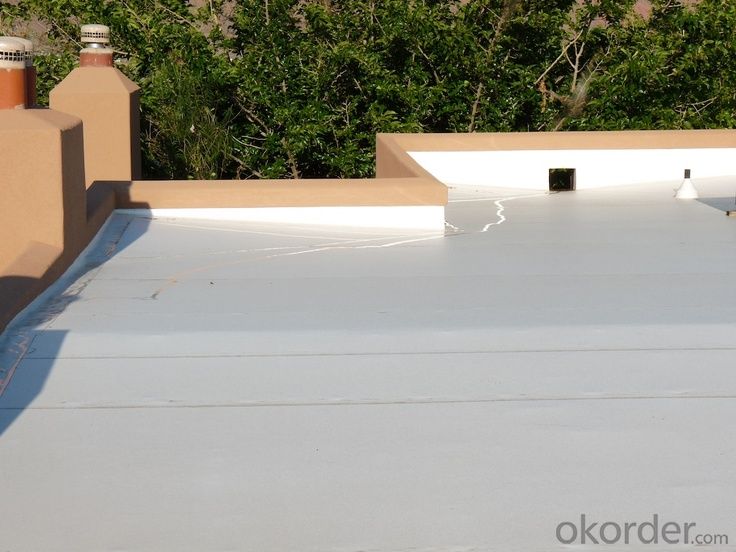
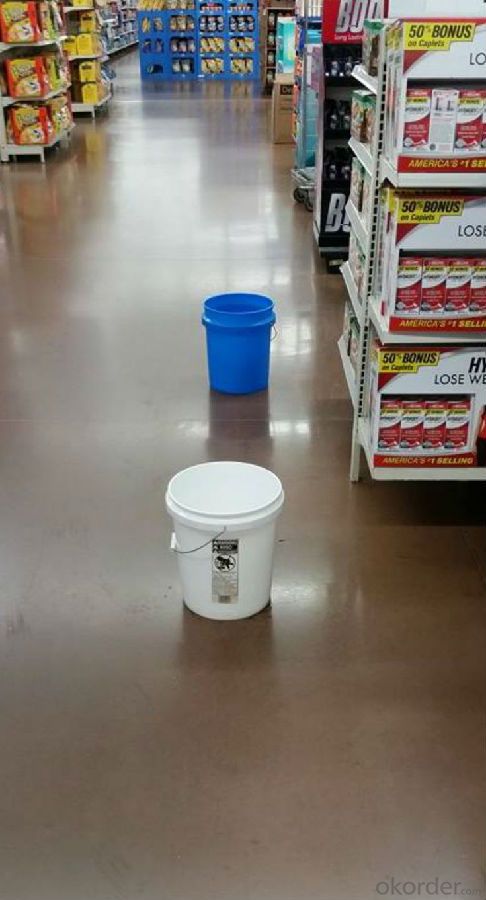
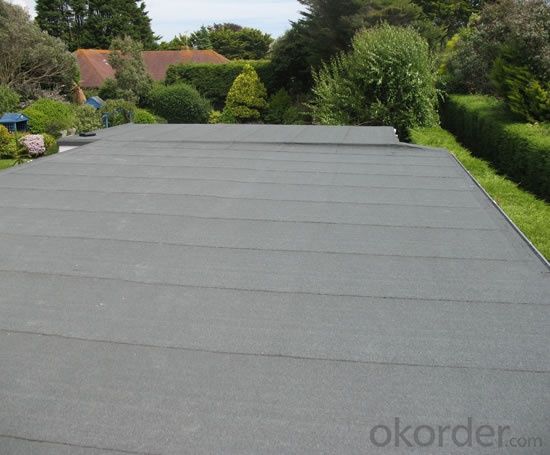
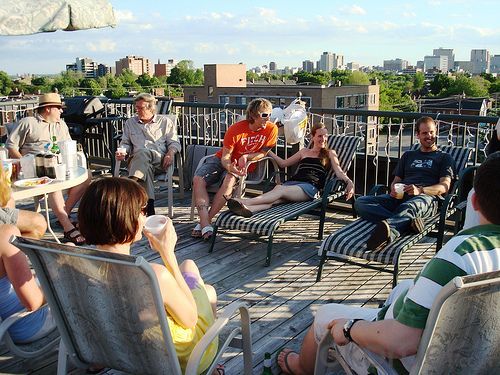
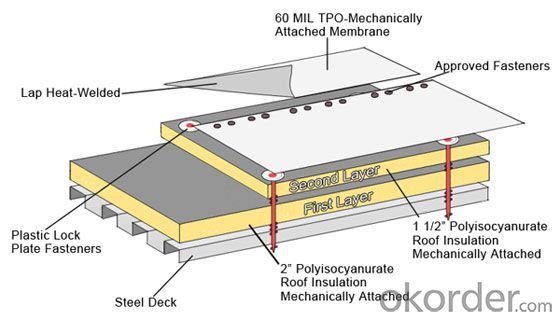
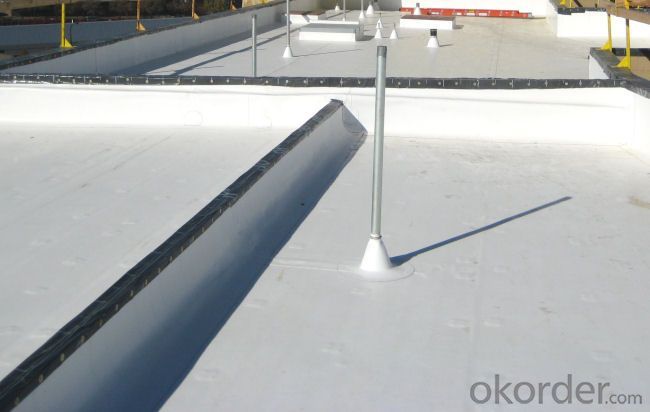
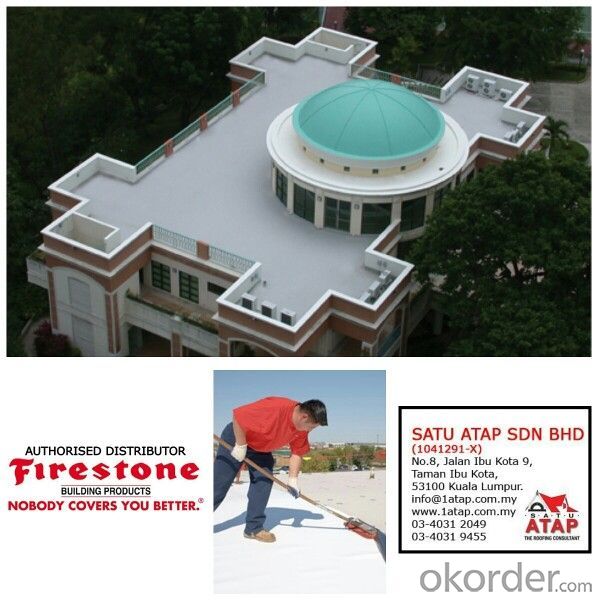

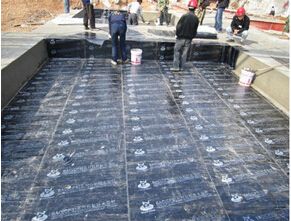
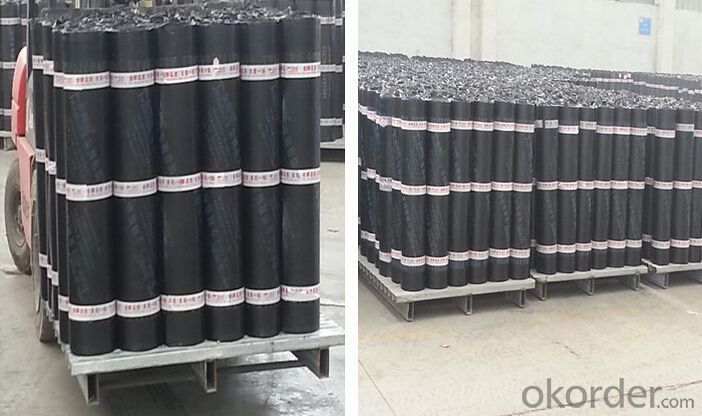

FAQ

- Q:How does a waterproofing membrane handle movement or settling of a building?
- A building's movement or settling can be accommodated by a waterproofing membrane in several ways. Firstly, the membrane is typically installed in a manner that allows it to stretch or flex as the building moves. This elasticity ensures that the membrane remains intact and continues to provide a watertight seal, even if the structure shifts or settles. In addition, waterproofing membranes often include reinforcement materials, such as fabrics or fibers, which enhance their ability to withstand movement. These reinforcements help distribute the stress or strain caused by building movement across a larger area, reducing the risk of tears or failures in the membrane. Moreover, certain waterproofing membranes are designed with built-in features that can handle significant movement. For instance, some membranes possess special "crack-bridging" properties, enabling them to span small cracks that may develop in the building's substrate due to settling. This ensures that the membrane remains effective, even if the structure sustains minor damage. In cases where a building is expected to experience significant movement or settling, specialized waterproofing systems, such as joint sealants or expansion joints, may be used in conjunction with the membrane. These systems are specifically designed to handle large or dynamic movements, providing additional protection against water infiltration. Overall, careful design and installation of a waterproofing membrane enable it to effectively handle a building's movement or settling. Its elasticity, reinforcement materials, and additional features ensure that it maintains a watertight seal, even when faced with structural shifts or settlement.
- Q:Can a waterproofing membrane be used in areas with high humidity?
- Yes, a waterproofing membrane can be used in areas with high humidity. The membrane is designed to prevent water penetration, including moisture from high humidity levels. It acts as a barrier, protecting the underlying surfaces from water damage, mold, and mildew.
- Q:Is a waterproofing membrane resistant to cracking or shrinking?
- Yes, a waterproofing membrane is designed to be resistant to cracking and shrinking, providing a durable and long-lasting solution for preventing water penetration.
- Q:Can a waterproofing membrane be pre-fabricated or pre-made for easy installation?
- Indeed, there are pre-fabricated or pre-made waterproofing membranes available for easy installation. Many manufacturers offer these membranes specifically designed to simplify the installation process. These membranes are usually manufactured in controlled factory conditions to ensure consistent quality and reduce the potential for errors during installation. Pre-fabricated waterproofing membranes are made from different materials, such as bitumen, PVC, EPDM, or TPO, and are available in various forms, including sheets or rolls. They are designed for easy transportation and on-site installation. The use of pre-fabricated waterproofing membranes brings several advantages, including increased efficiency, reduced labor costs, and improved installation quality. Contractors can save time and resources by eliminating the need for on-site fabrication. Additionally, pre-made membranes often come with detailed installation instructions, making it easier for contractors to ensure proper installation. Furthermore, pre-fabricated waterproofing membranes can be customized to meet specific project requirements, such as size, shape, or slope. This customization ensures a seamless and effective waterproofing solution. Overall, the use of pre-fabricated or pre-made waterproofing membranes can simplify the installation process significantly and provide a reliable and durable waterproofing solution for various applications, such as roofs, basements, and foundations.
- Q:Does a waterproofing membrane require any specific safety precautions during installation?
- Specific safety precautions are necessary when installing a waterproofing membrane. Consider the following key precautions: 1. Personal Protective Equipment (PPE): Installers must wear appropriate PPE, such as gloves, safety glasses, and protective clothing, to avoid skin contact with the membrane and potential chemical hazards. 2. Adequate Ventilation: Ensure that the installation area has proper ventilation to prevent the accumulation of fumes or vapors. If working in a confined space, use ventilation systems to eliminate any potentially harmful gases or odors. 3. Hazardous Chemicals: Some waterproofing membranes contain hazardous chemicals or solvents. Installers should carefully read and adhere to the manufacturer's instructions for handling and using these products. Proper storage, handling, and disposal of chemicals are crucial to prevent accidents or environmental contamination. 4. Slips and Falls: The surface can become slippery during installation, particularly when applying the membrane on wet surfaces. Installers should take precautions to maintain stability and utilize safety equipment like harnesses or guardrails when working at heights to prevent falls. 5. Heat Hazards: Proper installation of certain waterproofing membranes requires the use of heat. Installers should exercise caution when working with heat sources such as torches or heat guns to prevent burns or fire hazards. Keep fire extinguishers readily available and ensure that personnel receive adequate training on fire safety protocols. 6. Electrical Safety: Waterproofing membranes might be installed in areas where electrical systems are present. Installers should exercise caution when working near live electrical wires or outlets and adhere to proper electrical safety procedures to prevent electric shocks or fires. It is crucial for installers to undergo comprehensive training and diligently follow all safety guidelines provided by the manufacturer. This will help minimize the risk of accidents, injuries, or property damage during the installation process.
- Q:Is a waterproofing membrane suitable for both residential and commercial applications?
- Yes, a waterproofing membrane is suitable for both residential and commercial applications. A waterproofing membrane is a versatile material that can be used in various settings to protect buildings and structures from water damage. Whether it is a residential home or a commercial building, a waterproofing membrane can be applied to foundations, roofs, walls, and other areas that are susceptible to water infiltration. It provides a protective barrier that prevents water from seeping into the structure and causing damage such as leaks, mold, and deterioration. Additionally, a waterproofing membrane can be customized to meet the specific needs and requirements of both residential and commercial applications, making it a suitable choice for any type of building.
- Q:Are waterproofing membranes resistant to chemical solvents?
- Yes, waterproofing membranes are generally resistant to chemical solvents. They are designed to provide a barrier against water and other liquids, including chemical solvents, to prevent leakage and damage to the underlying structure.
- Q:Can waterproofing membranes be used on buried pipelines?
- Buried pipelines can benefit from the use of waterproofing membranes. These membranes are specifically designed to shield against water and moisture, and can be applied to a variety of surfaces, including buried pipelines. Typically, these membranes are constructed from materials like bitumen or synthetic polymers, which possess resistance to water penetration. When employed on buried pipelines, waterproofing membranes serve to prevent water infiltration, a process that can lead to corrosion and material deterioration. Acting as a barrier, they effectively halt water from reaching the surface of the pipeline, safeguarding it from potential moisture-induced harm. Furthermore, waterproofing membranes also offer protection against external elements like soil chemicals or gases, which may pose threats to the pipeline. By establishing a waterproof barrier, these membranes effectively extend the lifespan of buried pipelines, diminish maintenance expenses, and enhance overall performance. It is important to emphasize that the selection and application of waterproofing membranes should be entrusted to professionals who possess extensive knowledge in pipeline construction and waterproofing systems. Ensuring the effectiveness of these membranes requires proper installation techniques and compatibility with the pipeline material.
- Q:Can a waterproofing membrane be used for a sports facility?
- Yes, a waterproofing membrane can be used for a sports facility. Waterproofing membranes are commonly used to protect buildings and structures from water damage, including sports facilities. They can be applied to various surfaces such as roofs, walls, and floors to prevent water infiltration and ensure a dry and safe environment for athletes and spectators.
- Q:Can a waterproofing membrane reduce noise transmission?
- Indeed, noise transmission can be diminished by employing a waterproofing membrane. These membranes, usually composed of sound-insulating materials like rubber or synthetic polymers, when applied to various surfaces, establish a barrier that absorbs or obstructs sound waves. Consequently, the amount of noise able to permeate the structure is reduced. Moreover, these membranes serve the purpose of sealing gaps and cracks in walls or floors, thereby decreasing noise leakage. Hence, while their primary function is to prevent water infiltration, waterproofing membranes also offer the secondary advantage of lowering noise transmission.
1. Manufacturer Overview |
|
|---|---|
| Location | |
| Year Established | |
| Annual Output Value | |
| Main Markets | |
| Company Certifications | |
2. Manufacturer Certificates |
|
|---|---|
| a) Certification Name | |
| Range | |
| Reference | |
| Validity Period | |
3. Manufacturer Capability |
|
|---|---|
| a)Trade Capacity | |
| Nearest Port | |
| Export Percentage | |
| No.of Employees in Trade Department | |
| Language Spoken: | |
| b)Factory Information | |
| Factory Size: | |
| No. of Production Lines | |
| Contract Manufacturing | |
| Product Price Range | |
Send your message to us
SBS Elastomer Modified-bitumen Waterproof Membrane For Roof
- Loading Port:
- Shanghai
- Payment Terms:
- TT OR LC
- Min Order Qty:
- 1000 m²
- Supply Capability:
- 200000 m²/month
OKorder Service Pledge
OKorder Financial Service
Similar products
New products
Hot products
Related keywords
